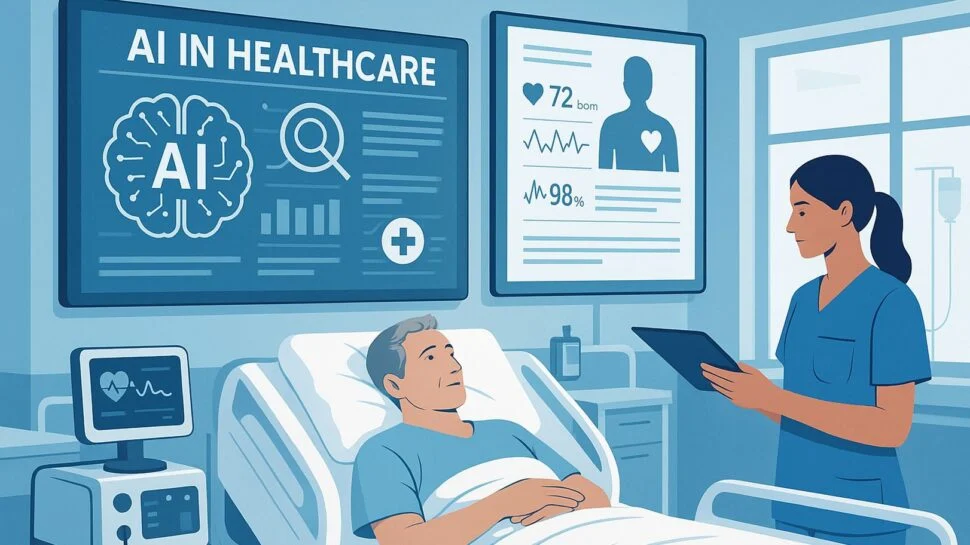In 2025, technology, data, and intelligent software solutions will fuel a significant revolution in the healthcare sector. Healthcare software development is now more important than ever as clinics, hospitals, and medical startups embrace digital transformation.
Healthcare software now drives AI-driven diagnostics, predictive analytics, virtual consultations, and tailored treatment in addition to managing patient information and payment systems. Innovation is revolutionizing healthcare delivery worldwide, from automated workflows to life-saving insights.
Let’s examine the key developments that will transform AI healthcare software development services in 2025 and make patient care faster, smarter, and more connected than it has ever been.
Artificial Intelligence (AI) and Machine Learning (ML): The Brains Behind Modern Healthcare
AI and ML remain at the heart of healthcare software innovation. In 2025, these technologies are no longer experimental — they’re mission-critical.
- AI-Powered Diagnostics: Machine learning algorithms are now capable of identifying diseases like cancer, diabetes, and cardiovascular issues with precision comparable to, or even exceeding, human experts.
- Predictive Analytics: AI-based healthcare software predicts patient outcomes, preventing critical conditions before they occur.
- Intelligent Automation: From appointment scheduling to insurance processing, AI automates time-consuming administrative tasks.
By learning from vast datasets, AI-driven software enables real-time clinical decisions, enhances accuracy, and reduces human error — paving the way for a truly data-driven healthcare ecosystem.
Telehealth and Remote Patient Monitoring
The COVID-19 pandemic triggered the global telehealth revolution, but in 2025, it has evolved into a permanent pillar of modern healthcare software.
- Remote Consultations: Telemedicine apps now integrate AI triage systems, EHR access, and secure video conferencing — making healthcare accessible to anyone, anywhere.
- Remote Patient Monitoring (RPM): Wearable devices and IoT sensors continuously track patient vitals, feeding data into AI-driven dashboards that alert doctors to anomalies.
This innovation has transformed chronic disease management, post-surgery care, and elderly health monitoring — providing continuous, real-time healthcare far beyond the hospital walls.
Internet of Medical Things (IoMT): Connecting Devices, Data, and Doctors
The Internet of Medical Things (IoMT) connects everything from wearable devices to hospital equipment, creating a seamless flow of real-time data.
In 2025, healthcare software integrates IoMT for:
- Smart Device Management: Real-time monitoring of patient vitals via smart sensors and connected devices.
- Data Interoperability: Secure data exchange between devices, hospitals, and cloud platforms.
- Predictive Maintenance: AI-driven monitoring of medical equipment performance to prevent downtime.
IoMT empowers doctors with data-driven insights, enabling proactive care rather than reactive treatment — a major leap toward precision medicine.
Generative AI and Natural Language Processing (NLP)
The emergence of Generative AI is transforming healthcare software into intelligent assistants capable of understanding, analyzing, and even generating medical content.
- Automated Documentation: Generative AI tools transcribe and summarize doctor-patient conversations into structured reports, saving hours of administrative work.
- Conversational AI Chatbots: NLP-driven chatbots offer 24/7 patient support, handle scheduling, and provide instant symptom-based guidance.
- Data Interpretation: AI models interpret vast medical datasets, helping clinicians derive actionable insights in seconds.
In 2025, healthcare software equipped with Generative AI reduces burnout, enhances efficiency, and keeps the focus on what truly matters — the patient.
Blockchain for Secure and Transparent Data Management
With the rise of digital healthcare solutions, data privacy and integrity are paramount. Blockchain technology has emerged as the answer to healthcare’s most pressing challenge — secure, transparent, and tamper-proof data sharing.
Healthcare software integrated with blockchain ensures:
- Immutable Medical Records: Every patient record is securely stored and verifiable.
- Seamless Data Exchange: Safe sharing between hospitals, insurers, and patients without intermediaries.
- Enhanced Trust: Transparent data transactions prevent fraud and misuse.
By 2025, blockchain is helping developers build HIPAA-compliant, patient-centered healthcare software that prioritizes security as much as innovation.
Cloud-Based Healthcare Solutions
Scalability and accessibility are vital for modern medical systems — and cloud computing is delivering exactly that.
Healthcare software in 2025 increasingly relies on cloud infrastructure for:
- Remote Data Access: Clinicians can securely access patient information anywhere, anytime.
- Interoperability: Integration of multiple hospital systems through centralized cloud platforms.
- Cost Efficiency: Eliminating on-premises data centers reduces costs while boosting performance.
Cloud-based healthcare software ensures data flexibility, collaboration, and continuity, making it essential for future-ready medical operations.
Personalized Medicine and Predictive Healthcare
Every patient is different — and so should be their treatment. In 2025, personalized healthcare software powered by AI and genomics tailors treatments based on individual profiles.
- Predictive Care Models: AI algorithms assess patient data to predict disease risks.
- Genomics Integration: Software platforms analyze DNA to customize medications and therapies.
- Lifestyle-Based Insights: Apps now provide lifestyle recommendations backed by predictive analytics.
This innovation is shifting the paradigm from reactive treatment to proactive care, empowering patients and physicians alike.
AR and VR in Medical Training and Patient Care
Augmented Reality (AR) and Virtual Reality (VR) are making healthcare software more immersive and effective.
- Surgical Simulations: Surgeons can practice complex procedures in virtual environments before operating on real patients.
- Therapeutic Applications: VR is being used to manage pain, anxiety, and mental health conditions.
- Patient Education: AR apps help visualize treatment procedures for better understanding and trust.
These technologies bring a human touch to digital healthcare, blending innovation with empathy.
Robotic Process Automation (RPA) in Healthcare Software
Healthcare organizations handle enormous administrative workloads — from claims processing to data entry.
RPA automates these repetitive tasks, ensuring accuracy and freeing up staff for more critical duties.
In 2025, healthcare software with RPA capabilities streamlines:
- Patient data entry
- Billing and claims processing
- Report generation
- Compliance checks
The result? A more efficient, cost-effective, and agile healthcare system.
Integration of Wearable Technology
Wearables like smartwatches and biosensors have become integral to healthcare software development.
In 2025, software platforms integrate data from devices like Apple Watch, Fitbit, and specialized medical wearables to:
- Track heart rate, oxygen levels, and activity
- Alert patients and doctors in case of irregularities
- Enable personalized health monitoring
By merging wearable tech with AI-powered software, healthcare systems gain continuous insight into patient well-being, driving preventive care at scale.
Low-Code and No-Code Healthcare Platforms
To speed up innovation, developers are turning to low-code and no-code platforms for healthcare software creation.
These platforms enable:
- Rapid app development without deep coding expertise
- Integration of AI, IoT, and data analytics modules
- Faster prototyping for startups and hospitals
In 2025, low-code tools are empowering healthcare providers to customize digital solutions faster, ensuring innovation keeps pace with demand.
Conclusion
Innovation will redefine healthcare in 2025. AI, IoMT, blockchain, and virtual reality are just a few examples of how technology is creating a world where healthcare is not only effective but also accessible, predictive, and personalized.
Healthcare software development firms like Code Brew Labs, who combine AI know-how, cutting-edge technology, and compliance-driven design to create future-ready healthcare solutions, are in the vanguard of this change.


